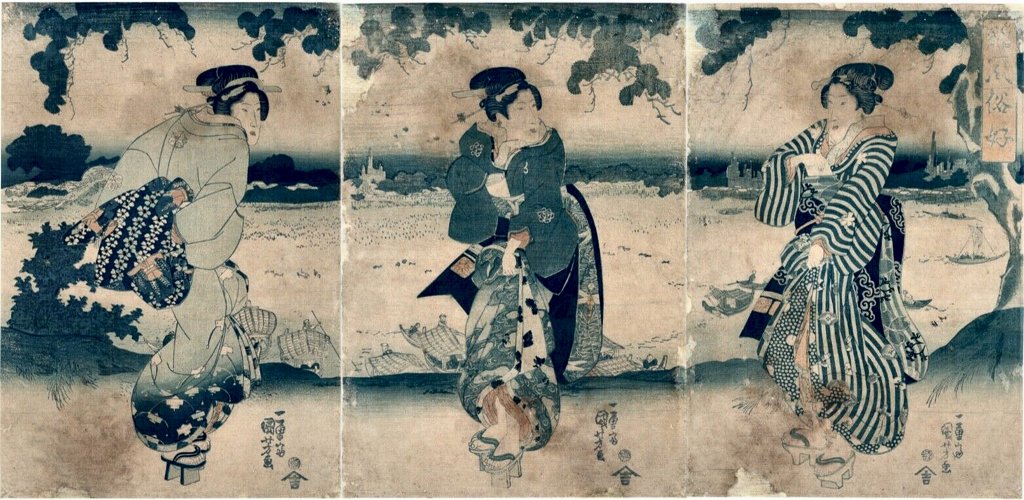| |
KUNIYOSHI(1797 - 1861)"Favourite Customs of the Present Day" |

"Favourite Customs of the Present
Day"
(Tôsei fûzoku kô, 当盛風俗好)
1830
Comment - The tryptich depicts three bijin
(beautiful women) standing on the bank of the Sumida River
that flows through modern day Tokyo. Several ships are moored
on the shore, others ply the Sumida. The left panel presents a
lady with her back turned to the viewer, revealing the sash of
her kimono decorated with several yakko kites. The motif of her
dress has associations with the Japanese festival of
Children’s Day traditionally celebrated in Spring. Sparsely
placed, the upper half of her robe is adorned with two
paulownia flowers.
The title of the triptych (Tôsei fûzoku kô, 当盛風俗好) is written in the cassette on right panel, upper right. The portraits of the beauties are completed entirely in Prussian blue. Entering Japan from the West, the then expensive and exotic blue pigment (Prussian Blue) sparked a wealth of inspiration for artists during the Edo period. These nearly monochromatic prints are named Aizuri-e. A version without the brownish colours is available.
Series - ~
Artist - see Biography
Signature - Ichiyûsai Kuniyoshi ga (一勇斎国芳画) on all three panels with circular date and censor's seals above the publishers mark
Publisher - Enomotoya Kichibei (榎本屋吉兵衛) from Hoeido Publishers (豊栄堂) with their Kichi Seal (吉) on all panels
Image Size - 38.1 x 75.1 cm (15" x 29 9/16")
The title of the triptych (Tôsei fûzoku kô, 当盛風俗好) is written in the cassette on right panel, upper right. The portraits of the beauties are completed entirely in Prussian blue. Entering Japan from the West, the then expensive and exotic blue pigment (Prussian Blue) sparked a wealth of inspiration for artists during the Edo period. These nearly monochromatic prints are named Aizuri-e. A version without the brownish colours is available.
Series - ~
Artist - see Biography
Signature - Ichiyûsai Kuniyoshi ga (一勇斎国芳画) on all three panels with circular date and censor's seals above the publishers mark
Publisher - Enomotoya Kichibei (榎本屋吉兵衛) from Hoeido Publishers (豊栄堂) with their Kichi Seal (吉) on all panels
Image Size - 38.1 x 75.1 cm (15" x 29 9/16")
Copyright 2008 ff: Hans P. Boehme